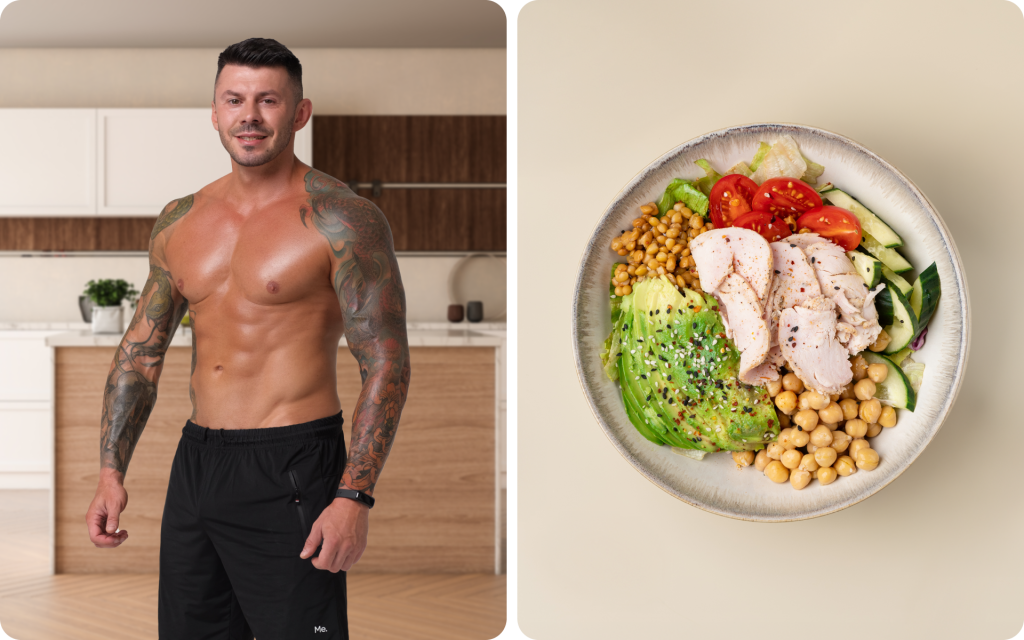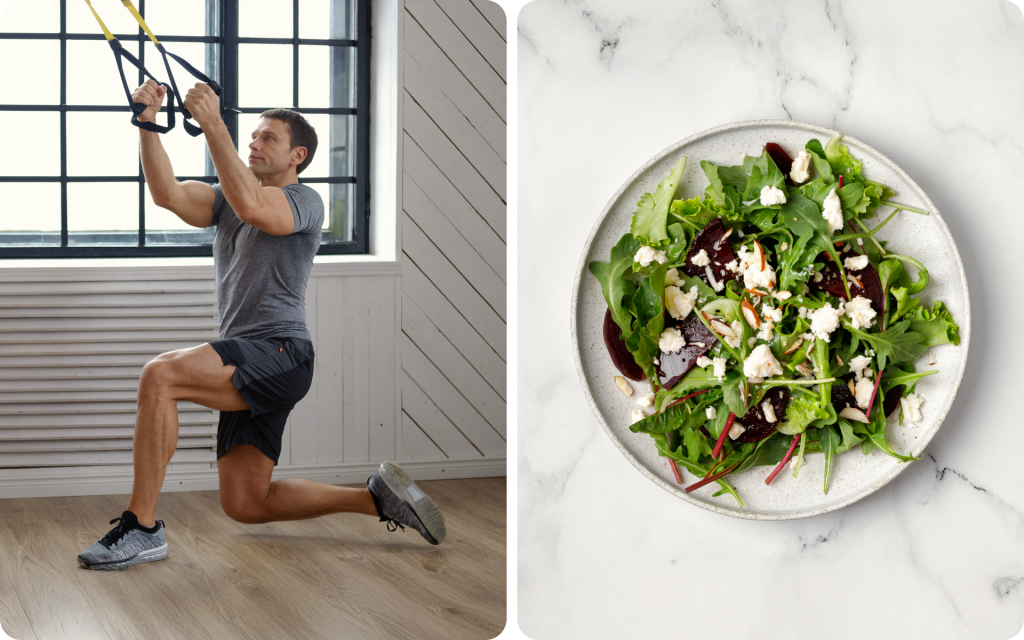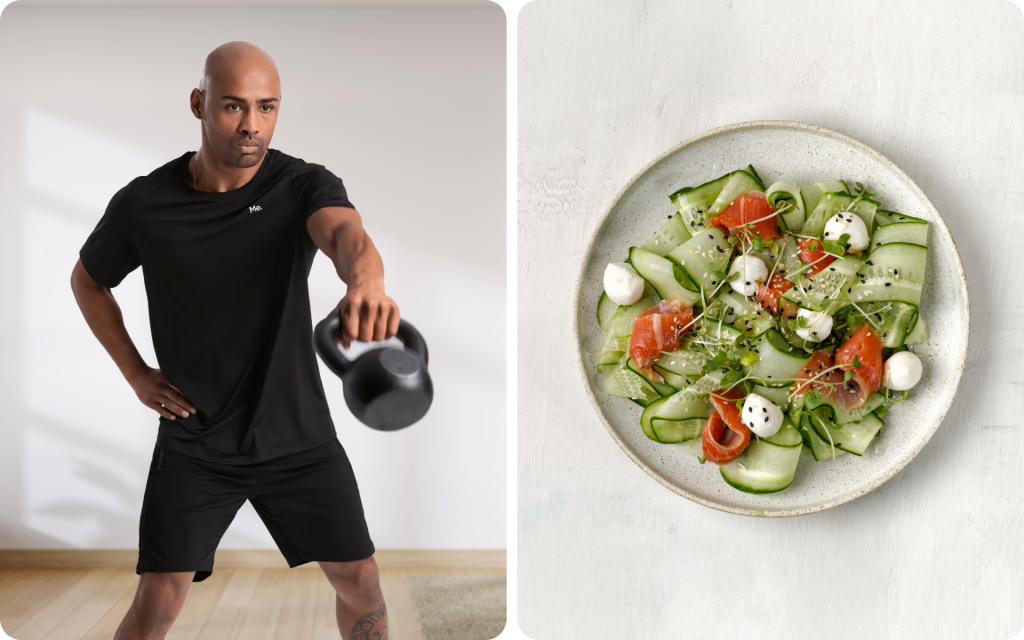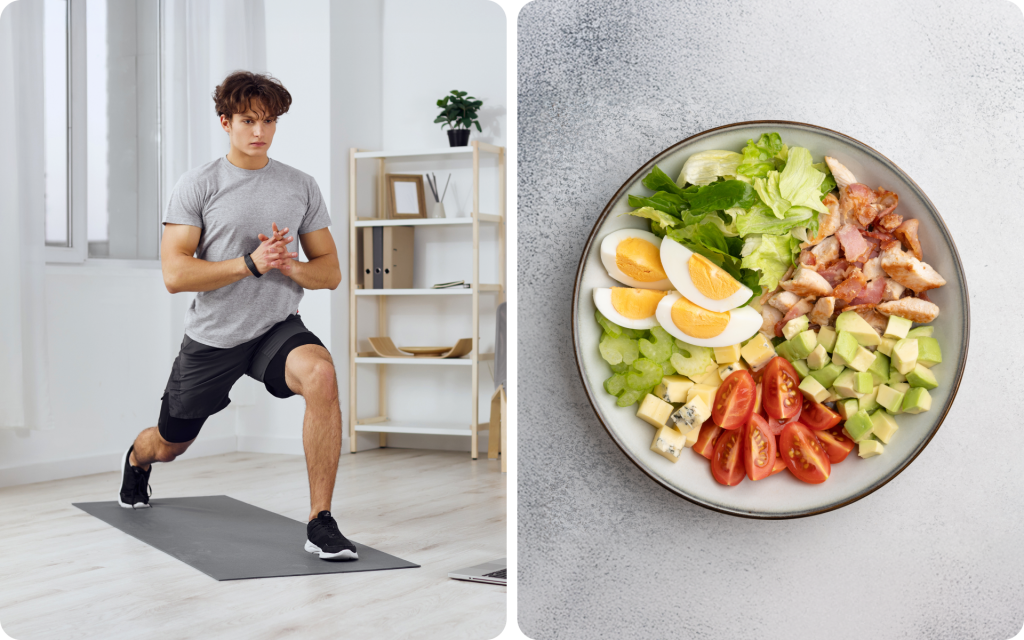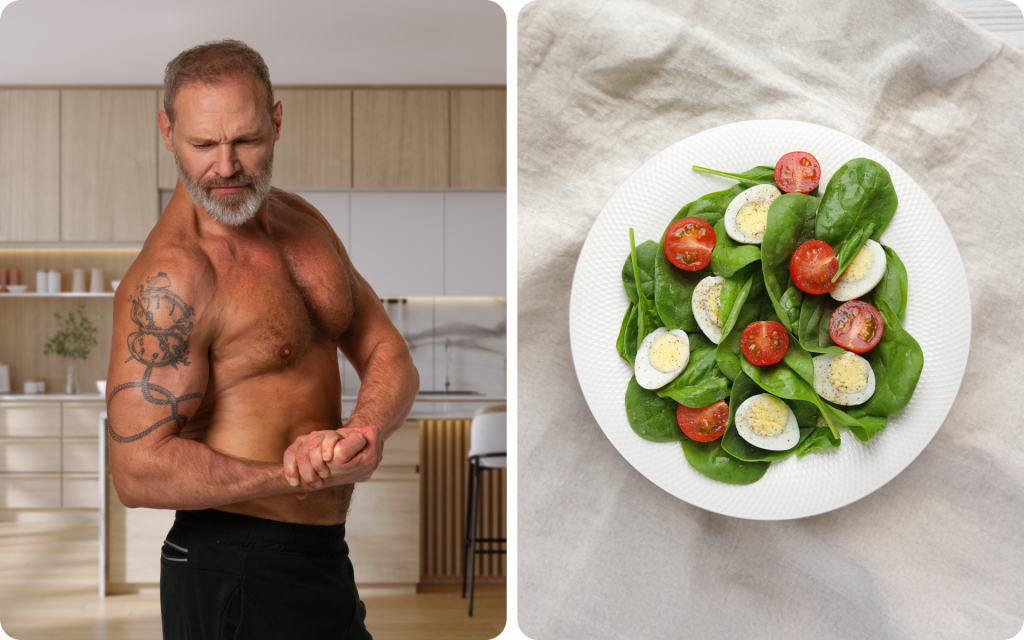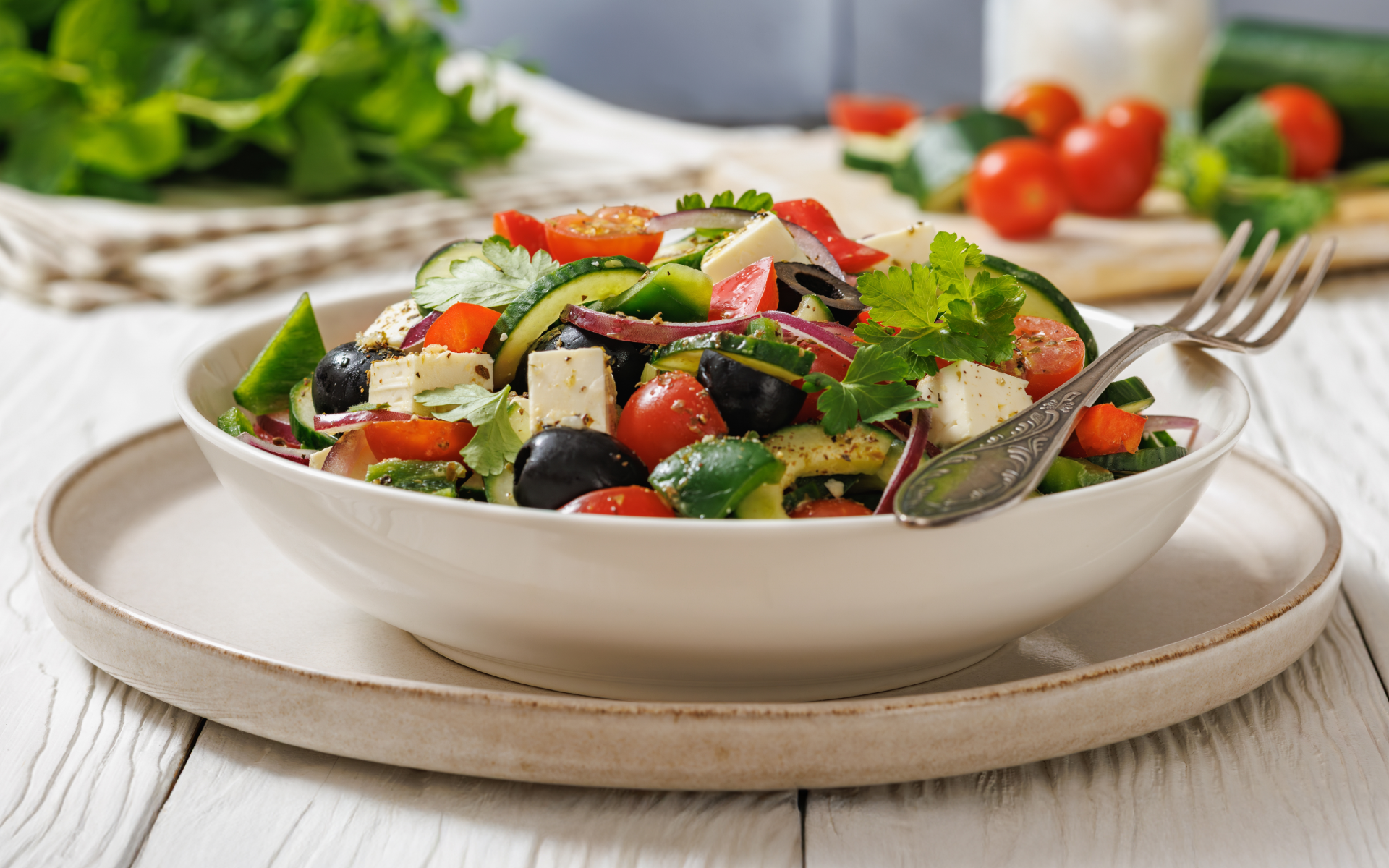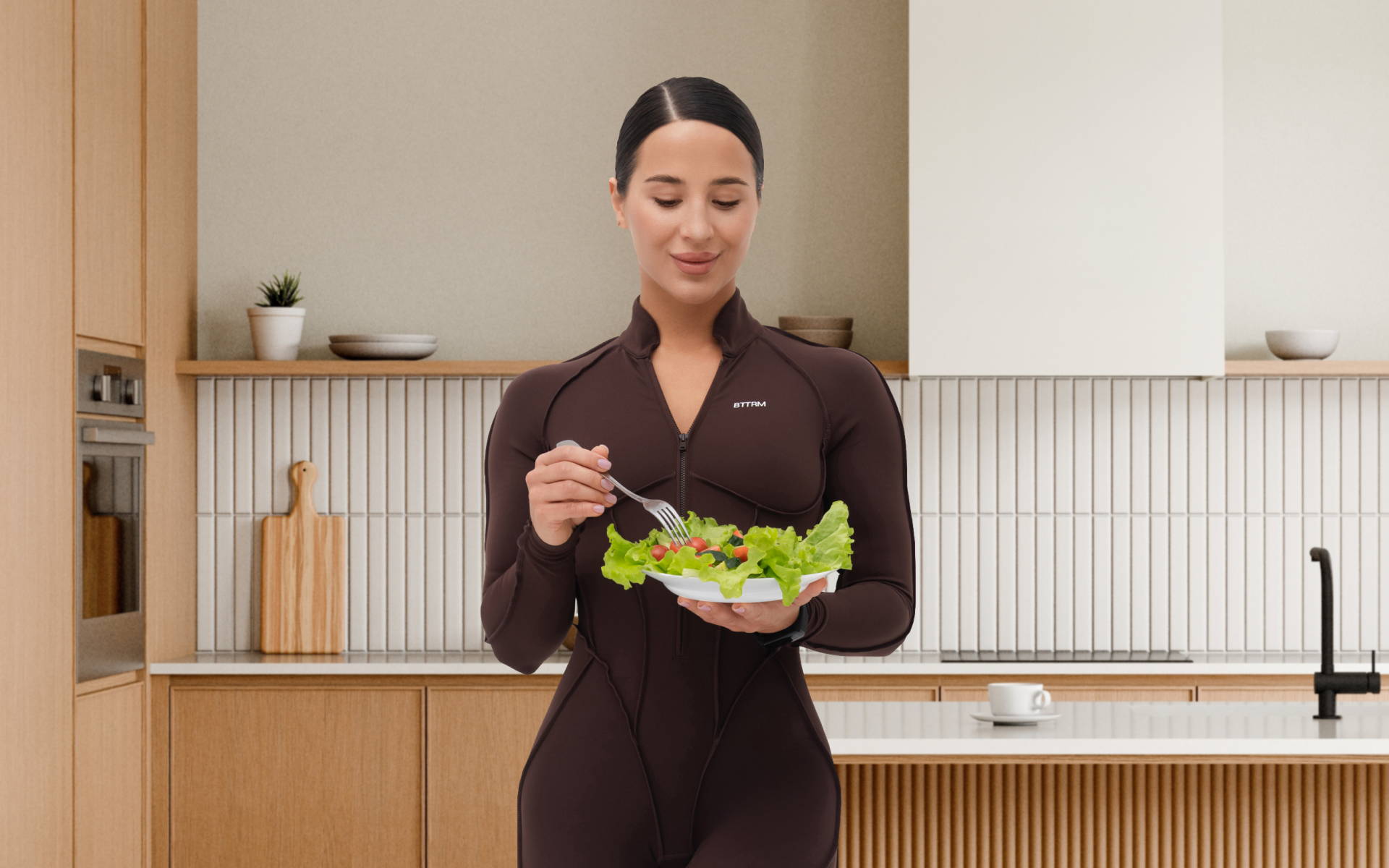Bulking is a term that is often used in fitness circles to describe a phase of intentional weight gain. It’s usually associated with building muscle mass by consuming more calories than you burn.
In reality, bulking is more nuanced than just eating in a calorie surplus. It’s about balancing macronutrients, timing meals strategically, and aligning your nutrition with your training goals.
Not all bulking strategies are equal. Factors such as your body composition, activity level, and metabolic rate play a huge role in determining what works best for you.
In this article, we’ll explore the science behind bulking, debunk common myths, and provide a practical guide to creating a meal plan that supports your goals.
How to Bulk up Quickly
Muscle growth or hypertrophy is the process by which muscle fibers increase in size, primarily in response to resistance training. This process is driven by a combination of mechanical tension, muscle cell signaling, and metabolic stress produced during demanding exercise (1).
Hypertrophy is also influenced by other interconnected factors – proper nutrition, adequate recovery, and careful self-assessment. There’s no shortcut, but there are strategies that can guarantee steady progress.
When you work your muscles with weights or other forms of resistance, your muscle cells receive signals telling them to grow stronger and bigger. These signals trigger muscle protein synthesis, which is the process your body uses to build new muscle tissue (2).
For your muscles to get larger over time, the amount of muscle you build (protein synthesis) needs to be greater than the amount your body breaks down (protein breakdown). Achieving this positive balance requires not only regular resistance training, but also enough high-quality nutrition – especially protein (3) – and good recovery practices such as restful sleep and rest days (4).
Genetics play a significant role in determining how quickly a person can bulk up. Factors such as muscle fiber type, hormonal profiles, and baseline metabolism differ from person to person. Some individuals naturally build muscle more easily due to a higher proportion of fast-twitch muscle fibers or favorable hormone levels (5).
While you can’t change your genetics, you can tailor your approach to work with your body’s unique capabilities.
What Is the Best Food to Eat for Bulk?
The best foods for bulking combine protein, complex carbs, healthy fats, and nutrients that fuel your workouts, aid recovery, and promote overall health.
Here are the key qualities to look for in ideal bulking foods, along with examples to help you stock your pantry wisely.
High in Protein
Protein is the building block of muscle, which makes it a key player in any bulking plan. Foods that are high in protein supply your body with amino acids, which are essential for muscle repair and growth (6). Aim for lean and diverse sources of protein to cover a wide range of nutrients.
Examples of High-Protein Foods:
- Chicken breast, turkey, and lean beef
- Eggs
- Fish such as salmon, cod, and tuna
- Greek yogurt and cottage cheese
- Plant-based options such as tofu, tempeh, beans, lentils, and edamame
The BetterMe: Health Coaching app will provide you with a host of fat-frying fitness routines that’ll scare the extra pounds away and turn your body into a masterpiece! Get your life moving in the right direction with BetterMe!
Calorie-Dense Options
When you’re aiming to bulk, you’ll need to consume more calories than you burn (in most cases) (7). Calorie-dense, nutrient-rich foods can make it easier to meet your energy needs without feeling overly full. Choose options that also pack in vitamins and minerals.
Examples of Calorie-Dense Foods:
- Nuts (almonds, walnuts, cashews) and nut butters
- Avocados
- Full-fat dairy products
- Whole-grain rice and pasta
- Fatty fish such as salmon
Rich in Carbohydrates
Carbohydrates are the primary energy source of your muscles. During a bulk, carbs replenish glycogen stores, which fuel performance and aid recovery after intense exercise (8). The best carbohydrate sources are those that are rich in fiber and nutrients.
Examples of Carb-Rich Foods:
- Oats and quinoa
- Brown rice and whole-grain pasta
- Sweet potatoes and regular potatoes
- Whole-wheat bread and wraps
- Fruits such as bananas, apples, and berries
Healthy Fats
Fats are essential for hormone production, which plays a vital role in muscle growth. They also provide a concentrated source of energy (9). Prioritize unsaturated fats, which support overall health, while keeping saturated fats in moderation.
Examples of Foods Rich in Healthy Fats:
- Olive oil, avocado oil, and other vegetable oils
- Nuts and seeds
- Fatty fish such as mackerel and sardines
Nutrient-Dense Options
Nutrient-dense foods provide vitamins, minerals, and antioxidants that support recovery and overall health. These options are ideal for keeping inflammation at bay and promoting optimal body function (10).
Examples of Nutrient-Dense Foods:
- Leafy greens such as spinach and kale
- Cruciferous vegetables such as broccoli and Brussels sprouts
- Brightly colored fruits such as oranges, berries, and watermelon
- Legumes such as chickpeas, black beans, and kidney beans
- Mushrooms and sweet bell peppers
Convenient and Versatile Foods
Sustainability is a key aspect of bulking. Foods that are easy to prepare and versatile in meals will help you stick to your plan in the long term. Look for staples you can use in a variety of dishes without getting bored (11).
Examples of Convenient, Versatile Foods:
- Eggs (scramble, boil, or fry them)
- Rice (pair with proteins and vegetables for balance)
- Potatoes (bake, mash, or roast them)
- Pre-cooked legumes or canned options
- Protein powders for quick shakes or recipes
- Frozen fruits and vegetables
Hydrating Choices
Hydration is often overlooked during a bulk, but staying well-hydrated is essential for muscle function and overall performance (12). While water is the best hydration source, some foods can also contribute to your fluid intake.
Examples of Hydrating Foods:
- Cucumbers and celery
- Watermelon and cantaloupe
- Oranges and grapefruit
- Broth-based soups
- Zucchini and iceberg lettuce
Read more: 50 Grams Of Carbs Per Day Meal Plan For The Keto Diet
What’s the Ideal Calorie Surplus in a Bulk Meal Plan?
A surplus provides the additional energy your body needs to support muscle growth, but striking the right balance is key.
While it may be tempting to jump straight into a large calorie surplus, this can have downsides. Consuming too many extra calories often leads to excessive fat gain, which can be difficult to shed later during a cutting phase.
By starting small, you give your body time to acclimate and can monitor changes in body composition more effectively.
Consider tracking your progress through a combination of methods:
- Measure body weight weekly under similar conditions (e.g. morning, fasted).
- Assess how your clothes fit and take progress photos.
- Monitor energy levels and strength gains during workouts.
The goal of muscle building should be to maximize gains while minimizing fat accumulation. You should aim for a weight gain of 0.5-1 pound per week (13). Faster rates can indicate an excessive surplus, leading to fat accumulation, while slower gains may mean you’re not eating enough to support muscle growth.
Here’s how you can calculate and customize your ideal calorie surplus.
Step 1: Calculate Your Basal Metabolic Rate (BMR)
Your BMR is the number of calories your body needs to perform basic functions such as breathing, circulation, and cell production at rest. It’s essentially the foundation of your daily energy needs (14).
Use the Mifflin-St Jeor Equation, which is one of the most accurate methods:
- For Men: BMR = 10 x weight (kg) + 6.25 x height (cm) – 5 x age (years) + 5
- For Women: BMR = 10 x weight (kg) + 6.25 x height (cm) – 5 x age (years) – 161
For example, a 30-year-old man who weighs 80 kg (176 lbs) and is 180 cm (5’11”) tall has a BMR of approximately 1,800 calories.
Step 2: Factor in Your Activity Level
Once you know your BMR, multiply it by an activity multiplier to estimate your total daily energy expenditure (TDEE), or the calories you need to maintain your current weight. Choose the multiplier that is based on your lifestyle:
- Sedentary (little to no exercise): BMR x 1.2
- Lightly active (light exercise 1-3 days/week): BMR x 1.375
- Moderately active (moderate exercise 3-5 days/week): BMR x 1.55
- Very active (hard exercise 6-7 days/week): BMR x 1.725
- Extremely active (very hard exercise or labor-intensive job): BMR x 1.9
For the same 80 kg man who is moderately active, his TDEE would be approximately 2,790 calories (1,800 x 1.55).
Step 3: Add a Calorie Surplus
For muscle growth, you need to consume slightly more calories than your TDEE. A common range is an additional 250-500 calories per day, depending on factors such as training intensity, metabolic rate, and your level of experience with bulking (7).
- Beginners: Start with a smaller surplus of 250-300 calories, as your body is more efficient at building muscle.
- Intermediate to Advanced Lifters: A surplus that is closer to 500 calories may be more appropriate, as muscle gains come slower and require more overall energy.
For our example, the man’s suggested intake for bulking would be around 3,000–3,300 calories per day. If this feels like a lot of math, there are plenty of free online calculators you can use that will do it for you.
How to Split Macros in a Muscle-Building Meal Plan
Macronutrients, or “macros”, include protein, carbohydrates, and fats, each serving a unique role in muscle building. Here’s how to structure your macro split for optimal results, with tips on how to adjust based on your body’s specific needs.
1. Protein: The Muscle-Building Powerhouse
Protein plays a starring role in muscle growth and repair. It provides the amino acids necessary for repairing muscle fibers after training and promoting hypertrophy. Research suggests that a daily protein intake of 1.2 to 1.6 grams per kilogram of body weight is appropriate for building muscle (15). For example:
- A 150-pound (68 kg) individual would need 82 to 109 grams of protein per day.
To distribute protein effectively, aim to consume it evenly across your meals. For a person who eats three meals a day, that’s around 25-40 grams of protein per meal.
Adjusting Protein Intake:
If you’re consistently feeling fatigued or recovering slowly, you may need to increase your protein slightly. On the other hand, for those who experience difficulty consuming enough calories, keeping your protein intake closer to the lower end of the range can leave more room for carbohydrates and fats.
2. Carbohydrates: Your Primary Energy Source
Carbohydrates fuel your workouts by replenishing glycogen stores in your muscles, which are depleted during resistance training. They also prevent your body from using protein for energy, allowing it to focus solely on muscle repair (8).
For muscle building, about 45-65% of your daily caloric intake should come from carbohydrates. Another general guideline is 2 to 7 grams of carbohydrates per pound of body weight (16). For example:
- A 150-pound individual needs 300 to 450 grams of carbohydrates per day.
Carbs should be consumed strategically:
- Pre-workout: Eat carb-rich meals or snacks to energize your session.
- Post-workout: Replenish muscle glycogen to kickstart recovery. Pair carbs with protein for optimal benefits.
Adjusting Carbohydrate Intake:
If you’re consistently low on energy or struggling to complete workouts, increase carb intake by 10-15%. Alternatively, if you’re gaining more fat than muscle, you might scale carbs back slightly and monitor progress.
3. Fats: Essential for Hormonal Health
While fats don’t directly build muscle, they play an essential supporting role by helping regulate hormones such as testosterone, which is the key to muscle growth. Fats also provide a concentrated source of energy (9), which is useful for meeting your calorie needs during a bulk.
For a muscle-building meal plan, aim for 20-30% of your daily caloric intake to come from fats. This equates to roughly 0.4 to 0.6 grams per pound of body weight (13). For example:
- A 150-pound individual needs approximately 60 to 90 grams of fat per day.
Focus on incorporating healthy fat sources, such as nuts, seeds, avocados, and olive oil, while keeping saturated fats in moderation.
Adjusting Fat Intake:
If you often feel hungry despite eating enough calories, increasing fat can help due to its high calorie density. Conversely, if fat gain is occurring too rapidly, you could consider reducing fats slightly in favor of protein or carbohydrates.
Example Macro Split for a 2,800-Calorie Bulk Meal Plan
Assuming a 55/25/20 distribution of carbs, protein, and fats:
- Carbohydrates (55%): 385 grams (1,540 calories)
- Protein (25%): 175 grams (700 calories)
- Fats (20%): 62 grams (560 calories)
Tailoring Macros to Your Needs
Your ideal macro split depends on multiple factors:
- Training Intensity: Higher-intensity workouts may require more carbohydrates for fuel.
- Body Composition Goals: If you’re striving for leaner gains, shift more calories to protein and reduce carbs slightly.
- Personal Preferences: Enjoying your meals is essential for sustainability, so adjust the proportions in a way that is aligned with foods you like and tolerate.
Is It Better to Eat 4 Small Meals or 2 Big Meals?
It’s best to choose the meal frequency that works best for your individual needs and schedule. Some people may prefer to eat smaller meals more frequently throughout the day, while others may find it easier to eat larger, less frequent meals.
Eating four small meals a day helps maintain steady energy levels by preventing blood sugar crashes, supports easier digestion with smaller portions (17), and promotes consistent protein intake for optimal muscle growth.
However, it also requires significant time and planning, which can be difficult for those with busy schedules. In addition, constantly eating may feel overwhelming or stressful, particularly during a bulk when appetite might not naturally be high.
Eating two big meals a day can be a simple and convenient option, reducing time spent on meal prep and making it easier to consume more calories for those with high energy needs. Larger meals can also leave you feeling full for longer, which is ideal for people who prefer fewer meals and snacks (17).
However, this approach comes with a risk of overeating, uneven protein distribution that could impact muscle synthesis, and possible energy dips during long gaps between meals, particularly for those with active lifestyles.
Pay attention to how meal timing affects your energy, workouts, and digestion. Adjust your meal frequency based on your observations.
Read more: High-Protein Meal Plan for Muscle Gain: Dos and Don’ts
How to Meal Prep a Weekly Bulk Plan Efficiently
Here’s a straightforward, step-by-step guide to help you meal prep efficiently while minimizing stress and food waste.
Step 1: Plan Your Weekly Meals and Macros
Before you even set foot in the kitchen, take some time to map out your meals.
- Determine Your Calorie and Macro Goals: Use your calculated daily requirements for protein, carbs, and fats as a foundation. For example, if you’re eating 3,000 calories a day, break that down into macros and decide how many meals or snacks you’ll need to hit your targets.
- Create a Meal Framework: Plan breakfast, lunch, dinner, and snacks with rough macro estimates for each. For instance, breakfast could be protein-heavy, lunches carb-focused for midday energy, and dinner balanced for recovery.
- Choose Recipes You’ll Enjoy: Balance variety with simplicity. Reuse ingredients across multiple dishes to cut costs and streamline prep. For example, grilled chicken can serve as a dinner main, salad topping, or snack protein.
Step 2: Shop Smart
A well-thought-out grocery trip saves time and ensures you have everything you need for the week.
- Make a Grocery List: Base it on your planned meals. Group items by store section (produce, protein, grains) for faster shopping.
- Opt for Staples in Bulk: Buying items such as rice, oats, sweet potatoes, chicken breasts, beans, eggs, and frozen vegetables in larger quantities saves money and reduces multiple trips to the store.
- Include Fresh and Frozen Options: While fresh produce is great, frozen vegetables and fruits are just as nutritious and help cut down on waste.
Step 3: Set Aside Time to Cook
Allocate a block of time – two to three hours, for example – to batch-cook everything for the week.
- Start with the Longest Tasks: Start cooking the items that take the longest time, such as grains (brown rice, quinoa), legumes, or roasted vegetables.
- Batch Cook Proteins: Grill, bake, or sauté large portions of chicken, lean ground beef, or tofu all at once. Season proteins differently if you want flavor variety during the week.
- Prep Quick Components Simultaneously: While larger items cook, chop vegetables, boil eggs, or portion snacks.
Step 4: Store That Food Properly
Keeping your meals organized and fresh is key to making them easy to grab and go.
- Use the Right Containers: Invest in sturdy, resealable containers. Glass containers are great for reheating, while stackable plastic ones save space.
- Portion Meals by Day or Macro: For convenience, store pre-made meals based on when you’ll eat them, or separate key macro components (such as 4-ounce servings of chicken, 1-cup rice portions).
- Label and Organize: Mark containers with the day of the week or contents. This eliminates guesswork during a busy schedule.
Step 5: Optimize Your Meal Prep Workflow
Prep doesn’t have to be tedious. These tips can help you save time and increase efficiency.
- Cook in Batches with Multi-Tasking: Prepare multiple meals simultaneously. For example, while the chicken roasts in the oven, you can sauté vegetables and boil pasta.
- Freeze Extras: Cook a little more than your plan calls for and freeze leftovers. This helps prevent food waste and gives you a buffer for unplanned days.
- Streamline Cleaning: Keep a sink with soapy water ready for rinsing utensils and cutting boards on the go.
Bonus Tips
- Aim for Complete Meals: Each meal should include a protein (e.g. chicken, tofu), a carbohydrate (e.g. rice, sweet potatoes), and a healthy fat (e.g. avocado, olive oil). Adding vegetables ensures your meals are nutrient-dense.
- Variety Without Overcomplication: Use the same base ingredients in different ways throughout the week. For example, roasted sweet potatoes could accompany chicken one night and pair with beans and eggs for a hearty breakfast the next day.
- Snack Wisely: Pre-portion and package calorie-dense snacks like trail mix, Greek yogurt with flaxseeds, or protein bars to ensure you can stay on track during busy moments.
We’ve compiled a list of bulking snacks that are both convenient to make and nutrient-dense – perfect for supporting muscle growth and increasing calorie intake.
How Long Should You Follow a Bulking Meal Plan?
There are no rules regarding how long a bulking phase should last. Most structured bulking periods range from 8 weeks to 6 months. A typical duration depends on your specific goals, current body composition, how comfortable you are with gradual weight gain, and your overall training plan.
Shorter bulks (8-12 weeks) may suit those who are aiming for modest muscle gains or who want to limit fat accumulation. Longer bulks (up to 6 months) can provide more time for meaningful muscle development, but increase the risk of excess fat gain if not monitored closely.
A few signs can help you determine when to transition out of bulking:
- Your rate of weight gain consistently exceeds 1 pound per week, which indicates that more fat is likely being accumulated.
- You notice a significant decline in energy, performance, or motivation.
- Your body composition changes – more fat than muscle gained – become noticeable in progress photos or measurements.
- You’re simply feeling uncomfortable or no longer enjoying the process.
Balancing your timeline with regular assessments ensures that your bulk supports your goals and keeps you on track for long-term health.
How to Avoid Fat Gain While Bulking
One of the most common fears with bulking is unintended fat gain. While some fat accumulation is normal—especially when increasing calories for muscle growth – it can be minimized with some smart strategies.
Monitor Your Progress Regularly:
Track your weight weekly, take progress photos, and check how your clothes fit. Combine objective measurements with how you feel physically and mentally.
Adjust Your Calorie Surplus:
Aim for a moderate calorie surplus – usually 250 to 500 calories per day is sufficient for most people. Too much surplus can accelerate fat gain, while too little may stunt muscle growth.
These high-calorie foods for bulking provide a dense mix of lean protein, healthy fats, and complex carbs, which makes them ideal for fueling muscle growth and meeting your daily caloric needs.
If you wish to free yourself from all the extra pounds that have been weighing you down for way too long, start using the BetterMe: Health Coaching app and overhaul your entire life!
Focus on Nutrient-Dense Foods:
Prioritize whole foods high in protein, fiber, vitamins, and minerals. Limit ultra-processed snacks that can add excess calories without much nutrition.
We’ve discussed a clean bulking meal plan that prioritizes whole foods, balanced macros, and strategic timing and can help you gain lean muscle without unnecessary fat gain.
Keep Protein Intake High:
Adequate protein helps support muscle gain and may lessen fat gain by increasing feelings of fullness and encouraging your body to retain lean mass.
Stay Active Outside the Gym:
Keep up with regular movement such as walking, stretching, or recreational activities. Non-exercise activity thermogenesis (NEAT) – the calories you burn outside of formal exercise – can help regulate fat gain.
Be Flexible With Adjustments:
If you start gaining more fat than you’re comfortable with, pull back on calories slightly or add an extra session of cardio. Stay attentive, but don’t overreact to small fluctuations week-to-week.
Prioritize Sleep and Stress Management:
Quality sleep and reduced stress improve your body’s ability to partition calories toward muscle rather than fat and optimize recovery.
Yes, 4 meals a day is sufficient for most people to meet calorie and protein needs during a bulk. The key is overall intake, not just meal frequency. Occasional junk food can fit into a bulking meal plan, but focus should remain on nutrient-dense, whole foods to support muscle growth and overall health. Aim for approximately 0.5 to 0.7 grams of protein per pound of body weight (1.2 to 1.6 grams per kilogram) daily to maximize muscle growth. Some people may go higher, but for most, it isn’t necessary. Start in this range and adjust as needed. Protein shakes aren’t required, but they can be a convenient way to help meet your daily protein and calorie targets.Frequently Asked Questions
Is 4 meals a day enough?
Can a bulking meal plan include junk food?
How much protein is needed in a bulking meal plan?
Do you need shakes in a bulk meal plan?
The Bottom Line
A meal plan for bulking isn’t about eating as much as possible or following a set formula, it’s about finding what works best for you. The keys to successful bulking are understanding your calorie needs, striking the right macro balance, and choosing nutrient-dense foods that support muscle growth without sacrificing overall health.
DISCLAIMER:
This article is intended for general informational purposes only and does not serve to address individual circumstances. It is not a substitute for professional advice or help and should not be relied on for making any kind of decision-making. Any action taken as a direct or indirect result of the information in this article is entirely at your own risk and is your sole responsibility.
BetterMe, its content staff, and its medical advisors accept no responsibility for inaccuracies, errors, misstatements, inconsistencies, or omissions and specifically disclaim any liability, loss or risk, personal, professional or otherwise, which may be incurred as a consequence, directly or indirectly, of the use and/or application of any content.
You should always seek the advice of your physician or other qualified health provider with any questions you may have regarding a medical condition or your specific situation. Never disregard professional medical advice or delay seeking it because of BetterMe content. If you suspect or think you may have a medical emergency, call your doctor.
SOURCES:
- Molecular Mechanisms of Skeletal Muscle Hypertrophy (2020, journals.sagepub.com)
- Resistance exercise and skeletal muscle: protein synthesis, degradation, and controversies (2025, link.springer.com)
- Editorial: Nutritional Strategies to Promote Muscle Mass and Function Across the Health Span (2020, frontiersin.org)
- The Importance of Recovery in Resistance Training Microcycle Construction (2024, pmc.ncbi.nlm.nih.gov)
- Gene’s role in attaining and maintaining muscle mass revealed (2024, news.northwestern.edu)
- Systematic review and meta-analysis of protein intake to support muscle mass and function in healthy adults (2022, onlinelibrary.wiley.com)
- Is an Energy Surplus Required to Maximize Skeletal Muscle Hypertrophy Associated With Resistance Training (2019, frontiersin.org)
- High-Quality Carbohydrates and Physical Performance (2018, journals.lww.com)
- Association of dietary fat intake with skeletal muscle mass and muscle strength in adults aged 20–59: NHANES 2011–2014 (2024, frontiersin.org)
- Overview of anti-inflammatory diets and their promising effects on non-communicable diseases (2024, cambridge.org)
- Home Meal Preparation: A Powerful Medical Intervention (2020, pmc.ncbi.nlm.nih.gov)
- Hydration to Maximize Performance And Recovery: Knowledge, Attitudes, and Behaviors Among Collegiate Track and Field Throwers (2021, jhk.termedia.pl)
- Nutrition Recommendations for Bodybuilders in the Off-Season: A Narrative Review (2019, mdpi.com)
- Non-Exercise Activity Thermogenesis in Human Energy Homeostasis (2022, ncbi.nlm.nih.gov)
- Synergistic Effect of Increased Total Protein Intake and Strength Training on Muscle Strength: A Dose-Response Meta-analysis of Randomized Controlled Trials (2022, sportsmedicine-open.springeropen.com)
- The Effect of Carbohydrate Intake on Strength and Resistance Training Performance: A Systematic Review (2022, mdpi.com)
- Small Meals vs. Large Meals: Which is Healthier? (2025, continentalhospitals.com)

